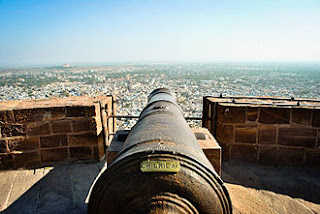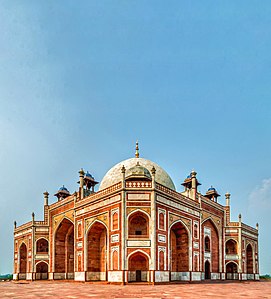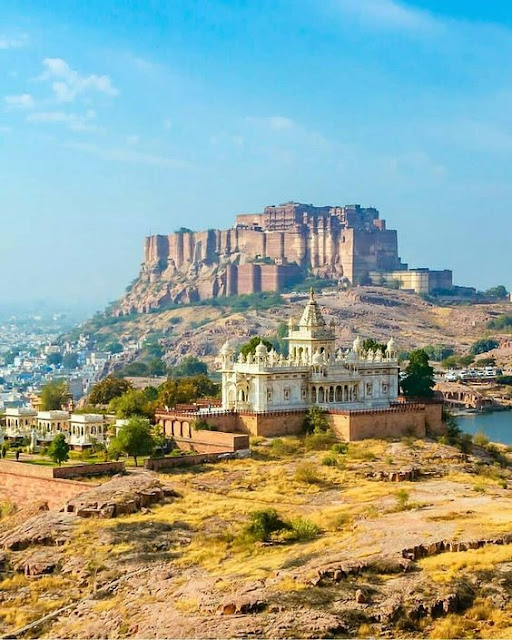Mehrangarh fort and museum india
Mehrangarh Fort and Museum
Mehrangarh or Mehran Fort, located in Jodhpur, Rajasthan, is one of the largest forts in India. Built-in around 1459 by Rao Jodha, the fort is situated 410 feet (125 m) above the city and is enclosed by imposing thick walls. Inside its boundaries, there are several palaces known for their intricate carvings and expansive courtyards. A winding road leads to and from the city below. The imprints of the impact of cannonballs fired by attacking armies of Jaipur can still be seen on the second gate. To the left of the fort is the chhatri of Kirat Singh Soda, a soldier who fell on the spot defending Mehrangarh.
There are seven gates, which include Jayapol (meaning 'victory gate'), built by Maharaja Man Singh to commemorate his victories over Jaipur and Bikaner armies. There is also a Fattehpol (also meaning 'victory gate'), which commemorates Maharaja Ajit Singhji's victory over Mughals.
The museum in the Mehrangarh fort is one of the most well-stocked museums in Rajasthan. In one section of the fort museum, there is a selection of old royal palanquins, including the elaborate domed gilt Mahadol palanquin which was won in a battle from the Governor of Gujarat in 1730. The museum exhibits the heritage of the Rathores in arms, costumes, paintings and decorated period.
History
Rao Jodha, the chief of the Rathore clan, is credited with the origin of Jodhpur in India. He founded Jodhpur in 1459 as the capital of Marwar (Mandore was the previous capital). He was one of Ranmal's 24 sons and became the fifteenth Rathore ruler. One year after his accession to the throne, Jodha decided to move his capital to the safer location of Jodhpur, as the one thousand years old Mandore fort was no longer considered to provide sufficient security.
With the trusted aid of Rao Nara (son of Rao Samra), the Mewar forces were subdued at Mandore. With that, Rao Jodha gave Rao Nara the title of Diwan. With the help of Rao Nara, the foundation of the fort was decided on 12 May 1459 by Jodha on a rocky hill 9 kilometers (5.6 mi) to the south of Mandore. This hill was known as Bhakurcheeria, the mountain of birds. According to legend to build the fort he had to displace the hill's sole human occupant, a hermit called Cheeria Nathji, the lord of birds. Cheers, Nathji was a man with the local population as his followers and hence influential in the region. When requested to move he refused categorically. This happened many times. Rao Jodha then took extreme measures and sought help from another more powerful saint, the female warrior sage of Charan caste Shri Karni Mata of Deshnok.On request of the king she came and asked Cheeria Nathji to quit immediately. Seeing a superior power he left at once but cursed Rao Jodha with words "Jodha! May your citadel ever suffer a scarcity of water!". Rao Jodha managed to appease the hermit by building a house and a temple in the fort. Seeing the influence of Karni Mata Rao Jodha then invited her to lay down the foundation stone of the Mehrangarh Fort and the same was carried out by her. Today only the forts of Bikaner and Jodhpur remain in the hands of Authors, both had their foundation stone laid by Shri Karni Mata. All other Rajput forts of Rajasthan were abandoned for some of the other reasons by the respective clans. Only the Authors of Jodhpur and Bikaner have their forts with them to date. This fact is considered a miracle by the local population and is attributed to Shri Karni Mata. Rao Jodha also granted villages of Mathania and Chopasni to the two Charan warlords who were sent by him to request Shri Karni Mata to come to Jodhpur.
To ensure that the new site proved propitious; he buried a man of the Meghwal caste called "Raja Ram Meghwal", who offered his services voluntarily, alive in the foundations as this was considered auspicious those days. "Raja Ram Meghwal" was promised that in return his family would be looked after by the Rathores. To this day his descendants still live in Raj Bagh, "Raja Ram Meghwal's" Garden.
Mehrangarh (etymology: 'Mihir' (Sanskrit) -sun or Sun-deity; 'Garh' (Sanskrit)-fort; i.e.' Sun-fort'); according to Rajasthani language pronunciation conventions, 'Mihirgarh' has changed to 'Mehrangarh'; the Sun-deity has been the chief deity of the Rathore dynasty. Though the fortress was originally started in 1459 by Rao Jodha, founder of Jodhpur, most of the fort which stands today dates from the period of Jaswant Singh of Marwar (1638–78). The fort is located at the center of the city spreading over 5 kilometers (3.1 mi) on top of a high hill. Its walls, which are up to 36 meters (118 ft) high and 21 meters (69 ft) wide, protect some of the most beautiful and historic palaces in Rajasthan.
The silhouette of the Mehrangarh fort against the sky at Jodhpur.
Entry to the fort is gained through a series of seven gates. The most famous of the gates are:
Jai Pol ("Gate of Victory"), built by Maharaja Man Singh in 1806 to celebrate his victory in a war with Jaipur and Bikaner.
Fateh Pol, built to celebrate a victory over the Mughals in 1707;
Dedh Kamagra Polo, which still bears the scars of bombardment by cannonballs;
Loha Pol, which is the final gate into the main part of the fort complex. Immediately to the left are the handprints (sati marks) of the ranis who in 1843 immolated themselves on the funeral pyre of their husband, Maharaja Man Singh.
Within the fort are several brilliantly crafted and decorated palaces. These include Moti Mahal (Pearl Palace), Phool Mahal (Flower Palace), Sheesha Mahal (Mirror Palace), Sileh Khana and Daulat Khana. The museum houses a collection of palanquins, howdahs, royal cradles, miniatures, musical instruments, costumes, and furniture. The ramparts of the fort house preserved old cannon (including the famous Kilkila) and provided a breath-taking view of the city.
Kilkila cannon
Galleries in Mehrangarh Museum
Elephant's howdahs
Mahidol, the Palanquin at Mehrangarh Museum
The howdahs were a kind of two-compartment wooden seat (mostly covered with gold and silver embossed sheets), which were fastened onto the elephant's back. The front compartment, with more leg space and a raised protective metal sheet, was meant for kings or royalty, and the rear smaller one for a reliable bodyguard disguised as a fly-whisk attendant.
Palanquins were a popular means of travel and circumambulation for the ladies of the nobility up to the second quarter of the 20th century. They were also used by male nobility and royals on special occasions.
Daulat Khana - Treasures of Mehrangarh Museum
This gallery displays one of the most important and best-preserved collections of fine and applied arts of the Mughal period of Indian history, during which the Rathore rulers of Jodhpur maintained close links with the Mughal emperors. It also has the remains of Emperor Akbar.
Armory
This gallery displays a rare collection of armor from every period in Jodhpur. On display are sword hilts in jade, silver, rhino horn, ivory, shields studded with rubies, emeralds and pearls and guns with gold and silver work on the barrels. The gallery also has on display the personal swords of many emperors, among them outstanding historical pieces like the Khanda of Rao Jodha, weighing over 3 kg, the sword of Akbar the Great and the sword of Timur.
Paintings
Folio from the Shiva Purana at Mehrangarh Museum, c. 1828.
This Gallery displays the colors of Marwar-Jodhpur, the finest example of Marwar paintings.
The Turban Gallery
The Turban Gallery in the Mehrangarh Museum seeks to preserve, document and display the many different types of turbans once prevalent in Rajasthan; every community, region, and festival having had its own head-gear.
Tourist attractions in Mehrangarh
National Geological Monument
The Jodhpur Group - Malani Igneous Suite Contact on which the Mehrangarh Fort has been built has been declared a National Geological Monument by the Geological Survey of India to encourage Geotourism in the country. This unique geological feature is part of the Malani Ingenus Suite seen in the Thar desert region, spread over an area of 43,500 km2. This unique geological feature represents the last phase of the igneous activity of Precambrian age in the Indian Subcontinent.
The Mataji Temple
Chamunda Devi Temple
The Chamundi Mataji was Rao Jodha's favorite goddess, he brought her idol from the old capital of Mandore in 1460 and installed her in Mehrangarh (Maa chamunda was the Devi of the Pratihara rulers of Mandore. She remains the Maharaja's and the Royal Family's Isht Devi or adopted goddess and is worshipped by most of Jodhpur's citizens as well. Crowds throng Mehrangarh during the Dussehra celebrations.
Rao Jodha Desert Rock Park
Rao Jodha Desert Rock Park, spreads over 72 hectares, adjoining Mehrangarh Fort. The park contains ecologically restored desert and arid land vegetation. The park was created in 2006 to try and restore the natural ecology of a large, rocky area adjoining and below the fort and opened to the public on February 2011. The area in and around the park contains distinctive volcanic rock formations such as rhyolite, with welded tuff, and breccia, sandstone formations. The park includes a Visitors Centre with Interpretation Gallery, a native plant nursery, a small shop, and a cafe.
2008 Stampede
A human stampede occurred on 30 September 2008, at the Chamunda Devi temple inside of the Mehrangarh Fort, in which 249 people were killed and more than 400 injured.
Culture
The Mehrangarh Fort at night.
The fort has musicians performing folk music at the entrance and houses museums, restaurants, exhibitions, and craft bazaars. The fort was one of the filming locations for Disney's 1994 live-action film The Jungle Book, as well as the 2012 film The Dark Knight Rises. Principal photography for the latter commenced on 6 May 2011. The Emraan Hashmi Awarapan was also shot here. In 2015, the fort was used to record a collaborative album by musicians including Israeli composer Shye Ben Tzur, English composer and Radiohead guitarist Jonny Greenwood, and Radiohead producer Nigel Godrich. The recording was the subject of a documentary, Junun, by the American director Paul Thomas Anderson. In March 2018, the film crew for the flop Bollywood film Thugs of Hindostan used the fort as one of its shooting locations; actor Amitabh Bachchan left a reflective post about his experience there on his official blog.






Comments